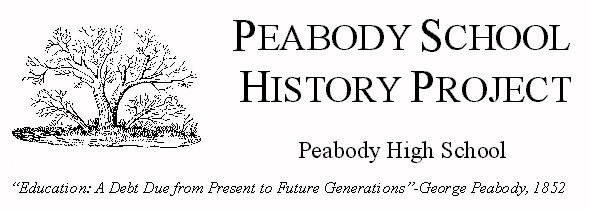

|
On John Proctor
Historical Figures
Learning under Double
Sessions
Appendices School Report by J.W. Proctor, 1847
Soldiers & Sports-
Misc. |
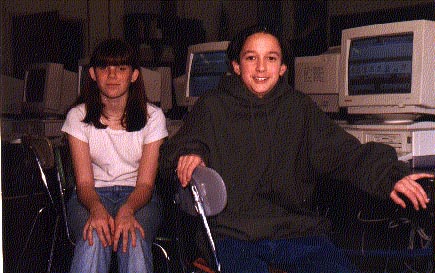 Photo by Kilmer Sweazy
The Peabody Veterans Memorial High School at 485 Lowell Street is the fifth high school to be built in Peabody. Until 1850, the town did not provide for public education higher than the ungraded, common district schools. The Danvers annual school report in 1849 reads, "This town needs a High
School; it wants, demands one; the law demands the same. A statute, which
until now has saved the town from prosecution, is, we are glad to say,
repealed. Although the state passed an act in 1840 that released the town
from the obligation of building a high school due to the town’s population;
however, in 1848, the obligation was re-imposed by the state."
Pursuing higher than common school education also meant families had to bear the cost of private education. The next year, the committee voted to spend $12,000 for the erection
of two High School buildings, one in the North, which became the Holten
High School, and the other in the South part of the town, in a building
on Park Street.
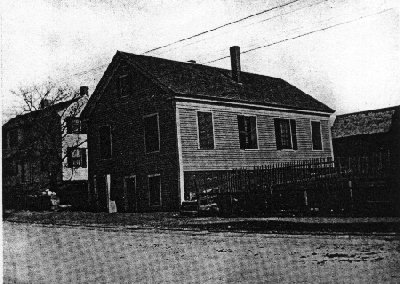 The high schools were arranged to have three terms that allowed for a three week vacation in August, a two week vacation over Thanksgiving and a three week vacation beginning in mid-March. The schools were open six hours a day, except on Saturday when the afternoon sessions were omitted. The following studies were pursued: Reading, Grammar, Declamation and
Composition (on Wednesday afternoons), Logic, Rhetoric, Geography-Ancient
and Modern, History-Ancient and Modern, Astronomy; Natural Theology; Natural
Philosophy, Physiology, Mental Philosophy, Geology, Chemistry, Botany,
Political Economy and Moral Science, Arithmetic, Book-Keeping, and the
Latin and Greek languages.
At a time when the district ranked two hundred and twenty-second in the Commonwealth in the average attendance of scholars, the attendance at the high school was very high all three terms. "The condition of the two High Schools is very satisfying and gratifying. That they have enlisted the interest and sympathy of our citizens, is very obvious from the fact that provision has been so freely made for the erection of two buildings suitable for their accommodation. These buildings are not only demanded for the convenience and comfort of the schools, but also that Danvers may favorably compete with other towns in offering inducements for strangers to settle within it limits. Nothing so much tends to the increase of property within any town, as wise and liberal appropriations for the cause of popular education. If those who sometimes complain of high taxes on school accounts, would view the subject in its true light, they might see that such taxes were the most sure and profitable investments they were ever called upon to make. "The mayor of Salem in his late inaugural address, uttered the following judicious and sensible remarks: - ‘The maintenance and advancement of our system of public education, in itself the only safe basis of our republican institutions, is felt to be, not more a matter of duty, than of interest. A schoolhouse is a better investment of the common fund, than stocks or bonds; and, ultimately, will yield a better return. It is wiser and cheaper to pay the teacher rather than the jailor or the keepers of our almshouses’" – Danvers Annual School Report, 1854. In the first class to graduate from the Peabody High School in 1854 was Samuel Brown, Jr.; he later became the namesake of one of the city’s elementary schools. In 1854, George Peabody of London announced his intention to create
a fund "the income of which should be forever used for prices and medals
to pupils at the Peabody and Holten high schools."
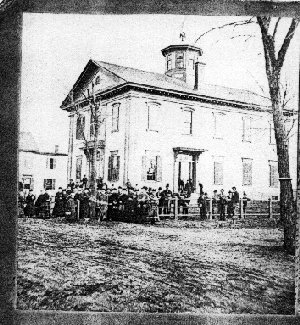 The decision crippled the school. Without an assistant, the school could not accept any new students in the spring of 1861 – as a consequence there was no graduating class in 1864. "The school must therefore limp along through the year like a bird with one wing," reads the Annual Report of the Schools for 1861. "Judging from the experience of former years there are 25 to 30 pupils now in the Grammar schools, qualified for promotion to the High School. They feel disappointed when they are told they must remain in the Grammar schools and go over the same routine of the last year in company with the class below them. But there is no remedy. The employment of a female assistant is all that is required to place the High School in a state of efficiency to the regular working of the other schools." The town’s action regarding the high school is ironic, in that the prudential committee, or school board, was acting progressively in 1861 by conducting a successful experiment to allow women teachers to teach both the summer and winter terms in the grammar schools in the rural districts. In 1863, the district completely abandoned the sexist policy requiring the change of teachers. "It has been our aim to place all the schools of the town on as nearly equal a footing as circumstances would allow. But great inequalities do and must exist. While in some districts the scholars are numbered by hundreds, in others, they scarcely include as many as tens. Here, the attendance is constant, with a well organized system of grade – there, want of system and inconstant attendance are almost the rule. But by far, the most serious evil under which the smaller Districts have labored, is, frequent change of teachers. It used to be thought that, though a lady was sufficient for the school during the Summer, only a male teacher was competent to carry it through the Winter. And so there must be a change, for that reason, once each year. Then, as the Prudential Committee are also apt to change yearly, there was no certainty that the views of the new Board would be like those of the last. We have sought to place female teachers in the grammar school of the smaller districts, throughout the year, and to make them as permanent as in the larger schools. Whatever weight might once have belonged to the objection that female teachers were not competent to manage a grammar school, it has now lost its force." A proposition to add to the old high school was dropped in 1913 on a vote of 3-to-2 because the old school "cannot be made suitable". Two years later, the town used the basement to make cement goods and evening school classes were transferred to the building. In 1921, there was an unsightly coal yard on the grounds of the old school and a fire broked out in January, 1922. After the fire, the school was discontinued as a place for school purposes. A resolution appeared in the School Committee Records in March commending
the bravery of "Miss Connor and the other teachers during the fire at the
old high school."
The Franklin Osborn estate on Central Street, opposite the Bowditch School, was purchased and Edward B. Balcomb of Peabody and Salem submitted plans for the new school . The cellar and foundation were installed in 1903. 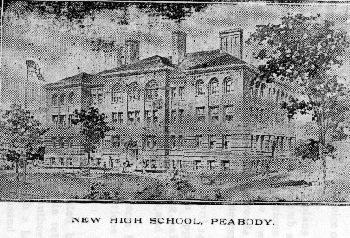 The 25-room building was 136 feet long by 80 feet wide and contained three stories. It sat 75 feet back from the road and was constructed of anti-porous, buff brick, "not ornamental in finish but strictly on the severe side." Over the front entrance to the school were gilded letters reading Peabody High School. The school, which had an assembly hall for 550, opened in September 1906. After six years of lobbying for an expansion of the school, the city voted to spend more than a half-million dollars in the 1920's to enlarge the high school. The addition of 16 classrooms, a library, a large assembly hall, a gymnasium and a new roof were accomplished by C.H. Cunningham and Son Company of Lynn. The architect was Frank Irving Cooper. The addition was primarily in the rear of the structure. When the school was renovated the community learned that the wiring in the original structure was unsafe. "For 17 years we've learned that this high school building was a fire-trap," commented Robert A. Bakeman, a member of the school committee. During the administration of principal Willard Woodman, the high school
had an orchestra in 1915 and a radio course was introduced in 1922. Around
the same time, a push was on to acquire land in the rear of the school
to complete the athletic field that was later named for Leo Buckley. (See:
Historical Figures by Chrissy Leblanc).
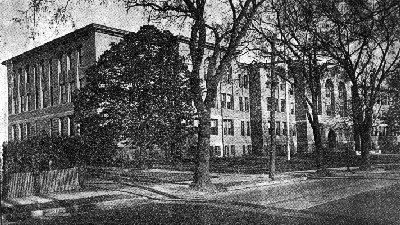 Until 1924 when Leo Buckley field opened, football games were played at Emerson Park. Telephone service was installed at the school in 1931, but the city failed to act on a grant for an addition to the high school in 1935 and lost the funding. As a result, in 1941, the school board asked the Works Progress Administration to start work on the high school after work was completed at two other city schools. While the state Supervisor of Secondary Education gave the high school
a positive review in 1941, seven years later, the inspector for the State
Department of Public Safety stated that he thought the high school building
was the most dangerous of all the local school plants. The school was rehabilitated
and expanded with the construction of a vocational school.
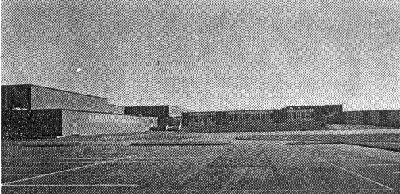 Fourth Peabody High School. The new high school campus opened in 1965 off Allen's Lane served as Peabody High School until 1972, when Peabody Veterans Memorial High School opened.. At that time, the school was designated as a junior high school and named in honor of long-time Superintendent J. Henry Higgins. For more information , see Peabody School History Project: Higgins Middle School. There was a second junior high school, the John F. Kennedy Junior High School, built in West Peabody in 1963. Two years later, increased enrollment prompted the district to consider instituting double sessions at the school. In 1971, the school board voted to reorganize grade level structure in the district. The Kennedy and Higgins Jr. High Schools were designated for grades 7, 8 and 9 and the high school under construction was geared to grades 10 through 12. Planning for the current high school, Peabody Veterans Memorial High
School, began in 1969. The opening of the school was delayed until 1972.
In preparing the site, peat was encountered when test borings were done which necessitated an additional 20,000 cubic yards of fill for the site. Later, excess top soil at the site had to be removed. The drainage plan for the site was also revised. Numerous change orders were also required to the $12 million project. The 296,000 square foot building is located on a 64-acre site located near the main street joining the downtown section of Peabody with the residential section of West Peabody. The school is located in a wooded area with appropriately placed athletic fields and parking areas. The building is a three-story structure with most of the general academic classrooms on the third floor and the specialized classrooms, including science classrooms and laboratories on the second floor. The Media Center, Language Lab and administrative offices are also located on the second floor. The first floor of the building contains a large entrance lobby, an eight hundred seat auditorium with adjoining music room, a large field house that will seat 2,000 for an athletic event, locker rooms, the school cafeteria, and planetarium. [Source: New England School Development Council School Facilities Master Plan, 1997] Equipment was moved into the school in August and originally the start-up date of September 1 appeared achievable. However, by the end of the month, it was apparent that the school would not be finished and the architect requested that the opening of school be delayed until September 13 for the school’s 1,925 students. Reasons for the delay included: an incomplete fire alarm system and the removal of numerous large boulders from the front entrance of the school, as well as the clean up of the school construction area. "It didn’t take long for word to spread through the city Tuesday that the new Veterans Memorial High School off Lowell Street will not open on schedule, having been postponed from September 8 to the 13th," read the Salem Evening News on September 1. "The School Department switchboard, which is already overburdened because all calls to the city’s schools are channeled through this board was ‘bombed’ with calls from parents and students seeking information. Detailed explanation had to be given callers because of the staggered system of students returning to school – 700 sophomores, Monday; 650 juniors, Tuesday and 575 seniors, Wednesday." When the deadline loomed less than 48-hours away, the school board announced on Saturday, September 11 that double sessions would be established at the old high school on Allen’s Lane. The school board and city officials reconvened and held an unprecedented, special emergency meeting on Sunday, September 12 in the cafeteria of the new school. At the meeting, it was decided to cancel the plan for double sessions and a meeting was planned with the State Department of Public Health for the following day. State Public Safety Inspector John B. Powers granted a temporary permit
for occupancy and required that eight Peabody firemen patrol the halls
of the school at a cost of $400 a day to insure safety regulations.
In the 1980’s, the first floor of the school was remodeled to convert the faculty dining room for an early childhood classroom and other classrooms were converted to vocational programs including culinary arts and cosmetology. A branch of the George Peabody Cooperative Bank (now the North Shore
Bank) also opened in the school lobby at that time. [Source: New England
School Development Council School Facilities Master Plan, 1997]
The Samuel Brown School was named in memory of Samuel Brown, Jr., a member of the first graduating class of Peabody High School, who died at the Battle of Antietam in 1862. When the principal and two students of the Peabody High School enlisted
in the service in 1863, the Annual School Report read,
"The Common School System in its highest development, is not only essentially
democratic both in its origin and its tendencies, but it is also the uncompromising
foe of oppression and misrule in all their forms. They flee before it as
the sun chases away the shades of darkness. Its aim is to enlighten the
masses, to give all a fair start in the race of life. Its tendency is to
unchain the minds of the people, to afford them a sure safe-guard against
the designs of the few who would use them for their own selfish and base
purposes."
Thompson enlisted in Capt. Robert S. Daniels’ company of nine months volunteers. He enlisted with George F. Barnes, the principal of the Bowditch School. (See Peabody School History Project: Samuel Brown School) They were both commissioned as lieutenants and sent to Newbern, North Carolina. In May, 1863 a list of pupils of Peabody High School who entered the
U.S. service was published in the South Danvers Wizard :Capt. Charles Dearborn,
Henry Moore, Perez L. Winchester, Charles Taggard, Horace Perry, and Donalson
Moore.
The West School was renamed in 1947 in honor of Peabody high school graduates who died on duty in the Pacific during World War II. (See: Peabody School History Project: Kiley Brothers Memorial School.) The library at the Peabody High School on Central Street was named in honor of The auditorium of the Center School was named in memory of Peabody High School graduate who died in World War II. (See: Peabody School History Project: Center School). The South Memorial School in 1952 and the West Memorial School were named in honor of all local veterans who gave their lives. On March 22, 1966, the school board opened the regular meeting with a moment of silent prayer and tribute to Marine P.F.C. John Savageau, a graduate of Peabody High School. Ruth Keane Sullivan was Savageau's fifth grade teacher at the Samuel Brown School. "I can even picture him in his seat near the window. He had an easy-going manner. How sad to kow that he had to end his life so early, but so honorably in wartime," she wrote. The McCarthy Memorial High School was named in 1969 in memory of Peabody High School graduate a Green Beret who died in Vietnam. (See: Peabody School History Project: McCarthy Memorial School). In November, 1969, the Peabody Veteran's Council, a composite of all the Veteran's organizations in the city, requested the new high school be named the "Peabody Veterans Memorial High School". The records state, "Because the Peabody Veteran's Memorial Council recognizes the great sacrifice of life and the individual and collective evidence of heroism and patriotism of all war veterans, it is their earnest request that the new senior high school be dedicated as a fitting memorial, for a grateful community, to the memory of all veterans of the City of Peabody who have made the supreme sacrifice in the service of the United States of America." The Veteran's Council also presented the School Committee with suggestions on naming different areas as special memorial areas. In October, 1972, the proposed names for the areas were approved as presented by Irving Bacherman of Veterans Memorial High School. House A PFC John H. Savageau Memorial House House B Sgt. Tony Lappas Memorial House House C S. 1/C Philip D. Quinlan Field House United States Army Memorial Field House Auditorium United States Navy Memorial Auditorium Cafeteria United State Air Force Memorial Cafeteria Library United States Marine Corps Memorial Library Study Hall United States Coast Guard Memorial Study Hall Planetarium Korean War Memorial Planetarium Band Room Vietnam War Memorial Band Room Vocal Music Room Old Glory Music Room Courtyards, Outer: Veterans of Foreign Wars Memorial Courtyard Jewish War Veterans Memorial Courtyard American Legion Memorial Courtyard Courtyards Inner Disabled American Veterans Memorial Courtyard Portuguese American War Veterans Memorial Courtyard Marine Corps League Memorial Courtyard In March 1997, the auditorium at the Higgins Middle School was named in honor of a veteran and graduate of Peabody High School. (See: Peabody School History Project: Higgins Middle School). Principals. Principals of Peabody High School: Eugene B. Hinckley, 1850-55; J. W. Colcord, 1855-57; L. B. Cushman, 1857-59; Robert E. Babson, 1859-60; V. H. Deane 1860 (temporary); William L. Thompson, 1860-62; Albert C. Perkings, 1862-3; Issac N. Carleton, 1863-1864; Henry Dame, 1864-69; Bryon Groce, 1869-74; James N. Ham, 1874-1883; J. Y. Bergen, Jr., 1883-88; Charles A. Holbrook, 1888-94; John M. Nichols, 1894-1900; Willard W. Woodman, 1900-34: Arthur J. Barry, 1934-68; William A. Welch, Jr., 1968-89; Joan Carr, 1989-97; Elaine Espindle (Interim for 2.5 months); Joseph Patuleia, 1997-present. The source of information for student reports, unless otherwise indicated, is from Peabody School Committee Records. |